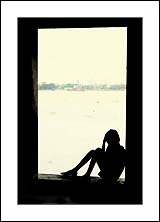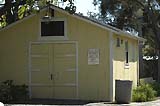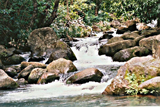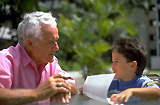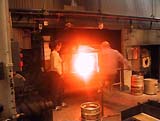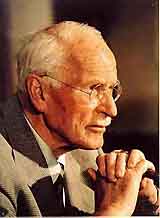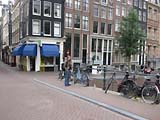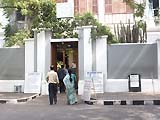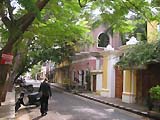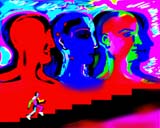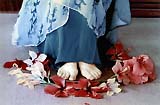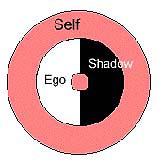Growth
Spontaneity of soul: an autobiographical glimpse
Editor's note
This is the last in the series of Dr. Arya Maloney's chapters on Alchemy of the Soul. It describes the author's own struggle in life and the role of the soul in it.
At age five I received my first formal teaching on the relationship between body and soul. In a catechism class taught by Roman Catholic nuns, I was informed that my reason for existence was to save my immortal soul. If I succeeded in controlling my body’s desires on earth, my soul would achieve eternal bliss in heaven. If I did not succeed, I would endure eternal separation from God. I was assured, nevertheless, that my body would be mysteriously resurrected and would eventually rejoin my soul at the end of the world.
Despite this promise of resurrection, I was left with the terrifying impression that body and soul were separate. I was to believe in the soul and work for its salvation — but not to experience it until after I died. Unable to sense a vital meaning in this convoluted message, my young mind grappled rebelliously with this injunction.
Fortunately, I had already felt the presence of my soul and continued to experience it with amazing regularity in spite of this formidable imprint.
Though the Church left its mark, the one left by my parents was deeper. My father had been coerced into marrying my eighteen-year-old, pregnant mother. Both were severely alcoholic and neither was capable of caring for a child. After three stormy years, my father left.
During the first three years of my life, I experienced fear, hunger and physical discomfort. My parent's physical and psychological absence exacerbated my instinct for survival. With no human presence to comfort me, I turned, in my need, to a deep unseen presence. Calling to my mother’s sodden, unconscious form as I stumbled through a dark, empty apartment, I sensed a greater self guiding me.
I sensed the presence of my soul.
When I was three, just before my father left, I walked away from our apartment complex in Buffalo, New York. My parents later referred to this episode as my being ‘lost’, I was not lost. Young as I was, I left intending to escape the unbearable pain of my life. As my small legs carried me away, I experienced an enormous sense of freedom. Though eventually two policemen returned me to my parents, I remember that as I rode in the squad car I was overcome with an inexplicable sense of newfound freedom.
Shortly after, my father abandoned my mother and myself by joining the army. We moved to my grandmother’s house. As I entered the sane space of my grandmother’s world, I was at last able to escape the chaos of living with two alcoholics. My mother continued to drink, but never in her mother’s home. Each afternoon she disappeared with her current drinking partner, not returning until the early morning hours. She would sleep, and then begin again the drunken cycle. Though I suffered periods of turmoil, for the most part I lived under the fierce protective love and care of my grandmother.
The joy I experienced during this period stands out in sharp contrast to the misery triggered by my mother’s abandonment. This ecstatic state emerged dramatically one day as I explored my grandmother’s land.
Abandonment made me adept at playing alone. I would trek eagerly from my grandmother’s kitchen through the dark woodshed and down the dirt path that led round the back of the house, continuing across the lawn and up the incline that led to a small outbuilding called the ‘honey-house’.
My body was alive with sensation. I was aware of the comforting kitchen odors, the woodshed’s fragrance, and the fresh air’s caress. I felt the weight of the massive wooden door, the solidity of the hard-packed dirt floor, the change of terrain as I left the lawn and entered the pasture’s taller grass. Simultaneously, I became aware of a burgeoning exhilaration, anticipation and joy. Upon entering the old, crumbling honey-house, I was enveloped by its sweet, sharp fragrance. Entranced, I observed the dance of a million minuscule particles magnified by the sun’s filtered rays. For the first time in my young life, I was plunged into a world of oneness. My usual feelings of separation, fear and sadness vanished. An ecstatic energy erased all boundaries, revealing honey, ancient wood, sun and dust as members of my own body.
Beyond the honey-house, a vast boulder strewn pasture beckoned. Ascending one of the giants, I nestled in a lichen-filled hollow and surveyed my kingdom. Here the dew, the eternal drone of the honey-gatherers, the wildflower perfume, all conspired to banish time and space from my consciousness.
Descending, I soon came upon my favorite companion — the rushing brook. Mesmerized by the sight of minnows, dragonflies and colored rocks, I stripped off my clothing and leaped in. Instantly, my overheated body became one with the cool water. Only the sound of my grandmother’s voice calling me to lunch was able to return me to ordinary reality.
Although I attended church, this world of honey and boulders and stream became the true temple of my soul. Here joy and ecstasy inhabited my bodily senses. I was no longer separate: I was an integral part of one enlarged body. This altered sense of reality, which, perhaps, all children experience, this earliest consciousness of the soul, has manifested itself many times in my lifetime. It invades my ordinary consciousness spontaneously. It reveals itself independently of my own will. Contrary to the church’s teaching, it enhances my awareness of ‘body’ in this lifetime.
This body-soul intimacy is not to be confused with reverie, trance or meditation. In these latter states, consciousness momentarily leaves the physical body. Transcending the body, it separates from the field of physical awareness, often leaving the body without sensation.
In my early childhood adventures, my soul-infused body not only amplified all my sensations, but transcended my ordinary perception of its limits. I did not leave my physical body: I inhabited it in a new way, becoming one with ‘other’bodies, like the stream or the high grass. Years later, however, my consciousness began to identify with my developing mind and my soul became temporarily veiled.
I was wrenched from my grandmother’s protective love at age six. My mother’s liaison with another man took us into an era which I think of as ‘the ten-year-war’. Seated in the back of my stepfather’s car, I waved for the last time to my beloved granny. Not wanting to cry, I stared straight ahead. The man and woman sitting in front of me appeared strange and ominous. My stepfather’s shaven head and porcine features chilled me. My mother’s disheveled hair and blank gaze sent my stomach plummeting. Intuitively, I perceived the shadows of the dark world I was about to enter.
From age six to sixteen I served a sentence in my stepfather’s ‘prison’. Robert Arquiett’s ‘prison’ was a large dairy farm on which I was forced to work daily from four in the morning until eight in the evening. Vacations or overnights with friends were non-existent; my only respite was the time spent in school. My stepfather eradicated any tendency towards laziness with his brutality. My mother, an inmate in her own right, passively witnessed the abuse I suffered.
This ten-year battle with my sadistic tormenter trained me in the art of contacting my soul. Recognizing his desire to break me, mentally, emotionally and physically, I was forced to turn inward. This strategy had to be skillfully employed since any withdrawal remotely resembling defiance would invite more abuse.
I learned how to please my captor through my capacity for physical work. Ignoring my academic performance, he responded only to my ability to match him (and his hired hands) in the arduous process of operating a large farm. Three hours before school, three hours after school, twelve-hour days of hard labor on weekends and vacations, became the rhythm of my life. Any deviation from this immutable schedule invited both physical and psychological abuse. My ordinary ways of being in the world — the clothing I wore, the food I ate, the praise I received from others — only opened me further to the sadistic denigration of this demon.
While my passage through this bizarre world of slavery, drunken brawls and brutality was eased by a strong mind and body, it was my grandmother’s love and that wider, indestructible ‘Self ’ discovered in her pasture, that saved me. Drawing strength from this core, I looked into the eyes of my enemy and knew he could not break me.
One day, at age twelve, after suffering severe humiliation at the hands of my stepfather, I paced the driveway in silent rage: in this dark moment I heard a clear, inner command, “You must leave this place or you will die”. Within months of this command, my natural father reappeared after an absence of nine years. He stayed only a few minutes, but those minutes opened the way to a short vacation with him — a vacation which further kindled my inner rebellion.
At age sixteen, during a rare respite from work, I was for the first time allowed to visit my maternal grandfather. Tasting this brief liberation, I asked to live with him. He agreed. I wrote to my mother who, true to her passivity and indifference, did not question my decision. At age sixteen, I at last escaped from a decade of slavery.
Though living with an alcoholic grandfather was far from idyllic, I experienced once again the freedom of a self-directed life. Simply not to be dragged from my bed at four in the morning seemed a miracle! The absence of constant abusive commentary allowed my nervous system to relax. Living without a ‘gun at my head’ filled me with a quiet joy.
My last two years of high school were pervaded by this sense of liberation.College became a possibility, a means to transcend the limitations of my family. Shamed by the economic and cultural poverty of my past, motivated by promise of employment, I was drawn to the study of science. I chose chemistry as a vehicle to lead me to freedom.
I worked in a glass factory thirty hours a week, double-shifts during summers, while I earned a Bachelor of Science degree. The apprenticeship in my stepfather’s workhouse had served me well! Marriage and entrance into a PhD program in physical organic chemistry followed undergraduate school. Yet, even as I pursued course work, comprehensive exams and experimental research, I became aware of an overwhelming interest in religion and philosophy. After much consideration, I left the path of science to study philosophy and religion..
For the next ten years, I was immersed in the academic world. Teaching courses as diverse as organic chemistry, Christian theology and Indian philosophy helped me to support a wife and two small children, as well as graduate studies. At the same time, I joined my students in a search for truth, and joined the anti-war movement. Throughout my graduate studies I maintained my identity with the Roman Catholic Church. Simultaneously however, with the growth of political consciousness and awareness of grave contradictions in the Church’s teaching, this identity dissolved. The Church could no longer nourish me spiritually.
During my twenty-ninth year my father contracted cancer. He was in my care for the last six months of his life. This passage led to a deep healing of our relationship. It also radically transformed my life. As I witnessed the diminishing of his body, I became keenly aware, not only of his death, but of my own: I knew, viscerally, that I, too, was dying. My life, seemingly so substantial until now, had grown empty. On the day of my father’s burial, I stepped onto a college picket line in protest of the Vietnam War. This strike led to the temporary closing of the college where I taught, thus radically transforming my life. Driven to discover a deeper reality, I now plunged into acts of civil disobedience against racism and poverty; and, above all, against our involvement in Vietnam. Experimentation with psychedelic drugs, meditation and trance induction followed. Not only was my external world altered, my psyche was also. Previously unexplored — I became aware of realms subconscious and superconscious.
These potent experiences, between 1968 and 1972, completely altered the direction of my life. My youthful marriage was crumbling, as was my relationship with academia. The college’s failure to renew the contract of a politically controversial colleague in 1970 prompted my resignation. I secured a position in the philosophy department of another university and discovered Eastern spirituality. A statement by Carl Jung (the great Swiss psychiatrist) connecting self-discovery and yoga, triggered my spiritual search. It led me to the Integral Yoga of Sri Aurobindo, the renowned Indian yogi who taught the spiritual transformation of the physical body, and the Mother, his spiritual partner.
Fascinated by the correlation between drug-induced states of consciousness and classical mystical experience, I decided to write my doctoral dissertation on this correlation. During this period, 1970 to 1972, I also became aware of Jean Houston’s and Robert Master’s work on altered states of consciousness. After reading their Varieties of Psychedelic Experience and Mind Games, I volunteered to be a research subject. In this experiment, trance-like effects were induced through movement and guided imagery. As a result, I experienced what felt like a powerful initiation from an inner figure — an old man with long white hair and beard, wearing an Indian dhoti (a cloth that wraps around the waist and drapes over one shoulder). In his presence, I experienced a rush of energy travelling from the base of my spine up and out the top of my head. I identified this figure as the ‘Wise Old Man’, a Jungian archetype symbolizing the true Self. Another year was to pass before I recognized the ‘Wise Old Man’ as Sri Aurobindo. Soon after, however, I could no longer enter these inner worlds. Then, on my thirty-second birthday, a friend gave me a compilation of Sri Aurobindo’s writings. Compelled by the power of his vision, I immediately purchased eight volumes of his work. I realized that Sri Aurobindo was the mystic in my vision and the focus of my dissertation.
Recognizing that my ‘failure’ to go into trance signaled a need to alter my course, Jean Houston, at that time my mentor, said, “If you are going to write about Sri Aurobindo, why not go to his ashram in India?” As she spoke, I knew I must go. In a matter of months, I was on my way. Thus began the journey that radically transformed my life.
Granted a six-month sabbatical from the university, I applied for an Indian visa. I was told that I had to receive my visa from an Indian Consulate in Europe, then continue to India. My daily phone calls met with disappointment — no visa. I rented a small room in Amsterdam and spent days in the local library reading Sri Aurobindo’s vast works. Steeping myself in his consciousness, I came to know experientially what the great sage calls Chit-shakti, Consciousness-Force, the power of the Mother (the feminine aspect of God). Chit-shakti awakened an energy that propelled me nightly through the streets of Amsterdam: I walked for miles along the canals, but not in my ordinary consciousness. It was as if an autonomous energy was ‘walking me’. Replaced by a conscious, inexhaustible force, ‘I’ became insubstantial, on the verge of disappearing.
During the day, however,’I’ returned with a vengeance. ‘What if the visa is not granted? My money is running out! Time is running out! I don’t have any control over this matter!’ Identification with this ‘I’ triggered a state of instant anxiety — the polar opposite of my evening state. One morning, I miraculously received an inner visitation from the Mother. “Do not worry, I will take care of everything”. Though I eagerly looked forward to meeting the Mother in the Pondicherry ashram (spiritual center), I was terrified. Sri Aurobindo’s yoga of surrender to the Mother had triggered the shadow-experiences of my own alcoholic mother as well as my images of a passive and weak Virgin Mary.
A profound calm descended. A sudden energy arose in my body as well as the knowledge that with or without a visa I must travel to India immediately. Despite India’s immigration practice of barring those without visas, I somehow knew the Mother would take care of everything. At New Delhi airport, I was fiercely interrogated,“You are breaking the law! We must put you on the next return flight !" Quietly, I told my story. Mysteriously, the chief officer softened and granted me a ten-day transit visa. As soon as I arrived, I felt completely at home in India. An official in the State Department became very interested in my quest and, after a long conversation about spiritual realization, promised to personally look into the matter of my visa. After ten days in Nepal, I was granted a visa to return to India.
Journeying via New Delhi, I arrived in Pondicherry on the anniversary of Sri Aurobindo’s birthday. I experienced Mother’s physical presence or darshan (transmission of divine consciousness) at the ashram, but by this time I had experienced many inner darshans which revealed the power of soul and the transparency of the human personality.
Slowly, She was opening the way.
I remained in the ashram from August 15 until December 21, 1973. On November 17, Mother left her physical body. Weeks later I attended a slide show of Mother’s life. A photograph of her descending a staircase, startlingly, came to life for me. With this, a pillar of intense energy entered the crown of my head: descending through my spine and legs into the earth, anchoring my consciousness in my body, it also catapulted me far beyond it.
Enveloped by this force-field, I continued to watch the slide show. The last image faded from the screen. The lights came on. I rose with my companion, left the theatre and set off through the streets of Pondicherry. Moving through the cool, jasmine-scented air, I became aware of a strange effortlessness. This harmony of motion manifested in the frictionless rotation of my shoulder joints, the synchronization of my arms and legs, the undulation of my spine and the sway of my pelvic girdle as it balanced my shifting weight. I experienced myself as a well-oiled machine powered by an inexhaustible source of energy. Possessed by this ecstasy, I was completely unaware of the speed at which I was traveling until my companion cried out, “Why are we in such a rush?”Awakened to my swift, harmonious strides, I reveled in this joy of movement. Simultaneously, with this awareness, came the astral experience of being in many locations at the same time — south India, the United States, Afghanistan.
For the next three days I continued to be moved by this pillar of energy. I was pervaded by a joy I had never known before. Previously, I had experienced the ascent of kundalinī energy — from the base of my spine to the crown of my head. This descent of energy, a reverse kundalinī, which had been triggered by the image of the Mother descending the staircase produced currents of energy that streamed through my arms, legs, torso and head.(1) These currents reduced my body’s density and created a lightness and plasticity. Persistent pressure in the area of my heart unleashed emotions of joy, ecstasy, longing and gratitude. My tears flowed with abandonment. I became sensitized to the emotional states of others. Even as I felt them in my own body, I realized that they were part of a larger energy field. As if by divine fiat, my narrow self-absorbed identity had been replaced by a soul identity. The veil of separation had been temporarily lifted.
During the following days I read Sri Aurobindo’s epic poem, Savitri and was drawn to the canto, `The Way of Fate and the Problem of Pain’. 'This canto describes the role of pain in the evolution of consciousness, and in the realization of the soul. As I read, each line triggered new sensations. His words became windows into a sea of consciousness, and I could feel their truth in the cells of my body.
Gradually, the intensity of this consciousness diminished. Its imprint, however, remained. paralleling the childhood imprint received at age three. These experiences and others have become beacons, guiding me steadily towards a reconciliation of personality and soul, permanently altering my vision of healing. For me, they have eradicated all doubt about the union of body and soul, affirming the manifestation of soul in the physical body. Returning to the West at the end of 1973, my focus as a psychotherapist radically shifted. Integrating the body, I no longer work exclusively with the mind and emotions.
In 1977, once again in India, I experienced further soul intervention. My partner during this period had become attracted to another man. Filled with a wild mixture of anger, sadness, anxiety and depression, I cycled to the Samādhī (a courtyard where Sri Aurobindo and the Mother are buried and people gather to meditate and offer flowers). Unable to sit, I was reduced to a frantic pacing. Breathing became rapid and shallow, my chest tight. A gnawing emptiness penetrated stomach and intestines. Envious of those seated in meditation, the best I could manage were brief moments of staring into space. Suddenly, pushing from within, an intense pressure invaded my heart. Immediately, the intense anxiety and depression lifted, and energy currents streamed through my body. Fear and contraction vanished. Suffused with gratitude for the pure act of existence, waves of love swept through me. I experienced the universal heart, realizing both animate and inanimate entities are part of a larger body. As if by divine fiat, my narrow, self-absorbed identity had been replaced by a soul-identity. The veil of separation had been temporarily lifted, revealing a cosmic web of energy.
Mounting my bicycle, I left the Samādhī and set off through the streets of Pondicherry. The intensity of the sun, as well as my own inner state, was tempered by a cool sea breeze. Where was the wretch who, barely an hour before, had been agitated beyond belief? Altered states of consciousness diminish. The walls of the ego return, as do anger, sadness and anxiety, however, the remembrance of the soul’s freedom remains.The gifts received, whether in my grandmother’s pasture or in India, have made me understand that I do not have to leave my physical body in order to experience my soul. Body, mind and emotions are instruments of the soul. The manifestation of the soul in the body unveils the role of each in the larger energy field.
If the soul is the integrator and healer, then spiritual practice is the means of opening the mind, body and emotions to its power. Much of spiritual practice, both Eastern and Western, aspires to either use body, mind and emotions in order to reach the soul, or abandon all three in order to reach this goal. The Integral Yoga of Sri Aurobindo and the Mother, however, acts on the body, mind and emotions — empowering them, making them conscious instruments of the soul.
My experiences have radically altered my vision of psychotherapy. I have realized that the soul can break through in emotionally taxing times as well as calm periods. The serious quest for the limitless soul requires a serious investigation of the limited personality. This exploration requires awareness, and quite often healing. It is the role of the soul in this healing process that draws me to further investigations.
Dwelling for years in a house, we suddenly discover a great central, connecting room. Discovery of this central room in the house of psychology will create a major revolution in our understanding of healing.
Epilogue
Suffering, the product of human experience, can come in the form of relational issues, illness and death, trauma or spiritual emergency as it did for those described in previous issues.Their healing journeys intersected and ultimately benefited from contact with the transpersonal or spiritual dimensions of the psyche. Though an earlier prototype of the psyche would have dismissed their experiences as pathological, the evolutionary, alchemical force of the soul is present in all human endeavor, including the field of psychology.
The stories of transformation presented earlier illustrate the acceleration of psychotherapy through the integral process of bridging the personal and transpersonal dimensions of consciousness. As we have seen, Joan was freed from a barren relationship through past-life experiences. Carrie traced the origin of her terminal illness beyond scientific materialism as the emergence of her soul revealed a new life in the presence of death. Julia discovered transpersonal, healing forces in her assent from an underworld of torture and abuse. And Bob was compelled to cope with a cosmic, transcendent consciousness which was not part of his life-plan.
In working with these experiences and others, I have felt the alchemy of the soul — the evolutionary force working to manifest a new center of consciousness in humanity. Unlike ego-centered psychology, soul-centered psychology offers an awareness of the inner as well as the outer world. It incorporates spiritual experience as an essential dimension of the human psyche. Sri Aurobindo takes this notion further by stressing the integral relationship between body, life-force, mind, soul and spirit.
As an integral healer, I approach healing with the understanding that each level of consciousness ultimately contains all others. This understanding incorporates :
1. A model of the human psyche possessing individual, universal and transcendent dimensions of consciousness as well as
2. A practice which recognizes the full spectrum of consciousness and its interdependent components.These components (body, emotion, mind, soul and spirit) which co-exist as energetic structures, differentiated only by vibrational frequencies, ultimately constitute an integrated whole.In this context, all that presents itself in an integral, therapeutic session can serve in the process of evolving consciousness.
Conquest of the difficult terrain between an egocentric and soul-centered awareness requires skill in both psychotherapy and spiritual practice. This effort demands the integration of these domains to create a discipline which honors all parts of our being — a creation marking an outstanding achievement of conscious evolution. Although psychotherapy and spirituality have ignored each other in the past, presently we are witnessing the emergence of transformational psychotherapies which employ the full spectrum of consciousness — from body to spirit. The pioneering work of Grof, Mindell and Raheem in the integration of body and spirit with mind and life-force has furthered a creative collaboration between once alienated practices. Efforts such as their's, coupled with Sri Aurobindo’s vision of a soul-centered individual, open the way for a radically new, evolutionary psychology. This opening possesses the power of joining body and spirit, ultimately giving birth to a greater psychology and a wider consciousness.
(1.) kundalinī energy is the conscious energy responsible for the manifestation of all form in the universe. Human beings are microcosms of the universe in which the potential energy kundalinī, that is not being used for the maintenance of the being, is stored in the base of the spine. All spiritual evolution involves an actualization of this energy.
Dr. Arya Maloney is the co-founder of the Mindbody Centre in Kingston, New York.
Share with us (Comments, contributions, opinions)
When reproducing this feature, please credit NAMAH, and give the byline. Please send us cuttings.


